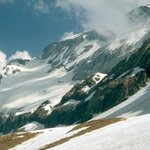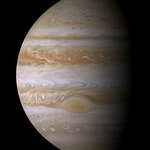Geology

Chemical clues from a comet’s halo are challenging common views about the history and evolution of the solar system and showing it may be more mixed-up than previously thought. A new analysis of dust from the comet Wild 2, collected in 2004 by NASA’s Stardust mission, has revealed an oxygen isotope signature that suggests an unexpected mingling of rocky material between the center and edges of the solar system. Despite the comet’s birth in the icy reaches of outer space beyond Pluto, tiny crystals collected from its halo appear to have been forged in the hotter interior, much closer to the…

The recent dramatic melting and breakup of a few huge Greenland glaciers have fueled public concerns over the impact of global climate change, but that isn't the island's biggest problem.
A new study shows that the dozens of much smaller outflow glaciers dotting Greenland's coast together account for three times more loss from the island's ice sheet than the amount coming from their huge relatives.
In a study just published in the journal Geophysical Research Letters, scientists at Ohio State University reported that nearly 75 percent of the loss of Greenland ice can be traced back to small…

The precise timing of the origin of life on Earth and the changes in life during the past 4.5 billion years has been a subject of great controversy for the past century.
The principal indicator of the amount of organic carbon produced by biological activity traditionally used is the ratio of the less abundant isotope of carbon, 13C, to the more abundant isotope, 12C. As plants preferentially incorporate 12C, during periods of high production of organic material the 13C/12C ratio of carbonate material becomes elevated.
Using this principle, the history of organic material has been…

Much has been said about the situation of the glaciers in Greenland and Antarctica, but less is known about those in the high mountain areas of the Iberian Peninsula. A Spanish research study states that active glaciers in the Pyrenees, which they say have seen a steady increase in temperature (0.9°C since 1890), will disappear before 2050.
Researchers from the University of Cantabria, the Autonomous University of Madrid and Valladolid have produced a summary on the current situation of the Pyrenees, Sierra Nevada and Picos de Europa. They based their work on how climate change has affected…

There is a lot of fuzz and even down right drama related to the forthcoming Large Hadron Collider experiment at CERN. I have started to call it the Lovely Hadron Collider because I think the science is great and I am a bad teaser...;-)
The Blue Marble by NASA/Reto Stöckli
Geodesy is the science of determining the geometry, gravitational field, and the rotation of the Earth and their evolution in time.
I just want to confirm that the shape of the planet Earth will stay the same even after the Lovely Hadron Collider is fueled up and running. I don't suspect reading the latest scientific…

Worldwide, there are between 50 and 70 volcanoes that erupt each year but due to the long gaps between eruptions it is difficult to pin down what triggers volcano behavior.
A team from Durham University and the University of Leeds, studied crystal formations from a volcano in Santorini, Greece, to calculate the timescale between the trigger of volcanic activity and the volcano’s eruption.
These crystals from the lava were able to tell them about the triggers for the volcano, they say, and could help civil defense agencies better prepare in the future.
The scientists looked at crystals from…

There is a great deal of concern about the effects of global warming on the Greenland ice sheet but scientists at the University of Bristol and the University of Leeds have taken the discussion to a deeper level - namely in stating that only changes in atmospheric carbon dioxide are able to explain the transition from the mostly ice-free Greenland of three million years ago to the ice-covered Greenland of today.
CO2 drops caused Greenland to become ice-covered so CO2 gains could undo that, they say.
There are several competing theories, ranging from changes in ocean circulation, the…

Diamonds from Brazil have provided the answers to a question that Earth scientists have been trying to understand for many years: how is oceanic crust that has been subducted deep into the Earth recycled back into volcanic rocks?
A team of researchers from the University of Bristol and the STFC Daresbury Laboratory, have gained a deeper insight into how the Earth recycles itself in the deep earth tectonic cycle way beyond the depths that can be accessed by drilling. The full paper on this research was published in Nature.
The Earth’s oceanic crust is constantly renewed in a cycle which has…

A strange, metal brew lies buried deep within Jupiter and Saturn, according to a new study by researchers at the University of California, Berkeley, and in London.
The study, published in this week's online edition of the journal Proceedings of the National Academy of Sciences, demonstrates that metallic helium is less rare than was previously thought and is produced under the kinds of conditions present at the centers of giant, gaseous planets, mixing with metal hydrogen and forming a liquid metal alloy.
Results from UC Berkeley and London researchers suggest that giant, gaseous planets…

Have you ever wondered what our world would look like stripped bare of all plants, soils, water and man-made structures?
So have earth and computer scientists from 79 nations who are working together on a global project called OneGeology to produce the first digital geological map of the world.
Images of the Earth as never seen before have been unveiled in what is the world’s biggest geological mapping project ever.
Begun just over a year ago, the project is doing for the rocks beneath our feet what Google does for maps of the Earth’s surface. Pretty fast for a science that usually counts…